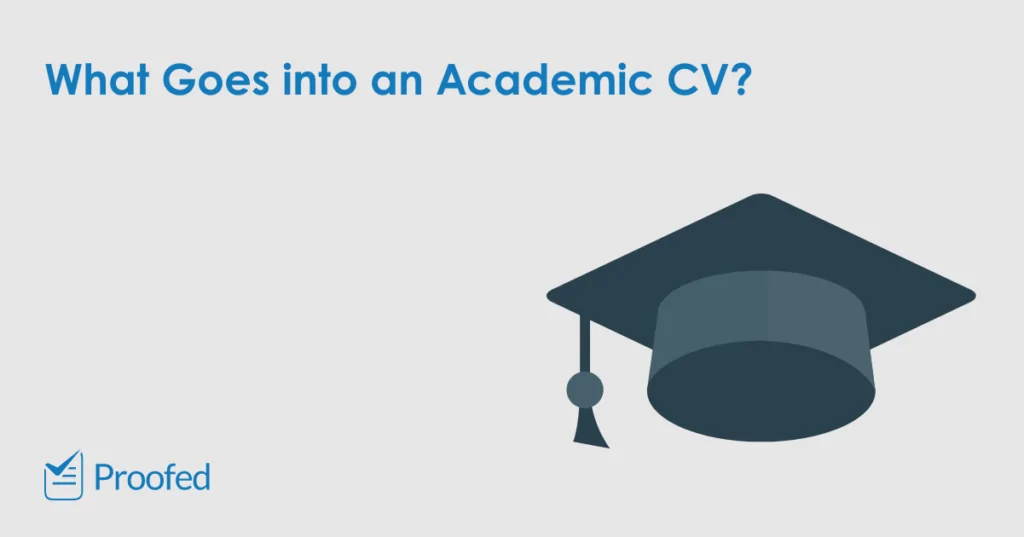If you’re applying for a role in academia, you’ll need a strong academic CV or resume. But what should this look like? Key elements to feature include:
- Your personal details, such as your name and contact information.
- A personal statement that summarises your career.
- Your education history in reverse chronological order.
- Previous academic appointments and teaching experience.
- Publications, including forthcoming publications and works under review.
- Information on funding (e.g. grants, fellowships, and scholarships).
- Information on conference presentations and talks you’ve given.
- Other relevant details, such as professional memberships and training.
- Details about your academic referees.
For more on all the above, plus some general tips for putting your academic CV together in a way that highlights your strengths, read on below.
1. Personal Details
As with any CV, you should start with personal details. This usually includes your name, address, telephone number, and your email address.
Don’t include personal information that isn’t relevant to the role.
2. Personal Statement
Next, include a personal statement that summarises your career, research interests, and your current position (if relevant). Keep this section brief (ideally one paragraph). You can even use bullet points for clarity if it helps.
3. Education History
List your degrees in reverse chronological order so that the most recent (and therefore most relevant) comes first. Include the following details:
- Type of degree and focus.
- Department and institution.
- Completion date (or expected completion date).
- Title of your dissertation or thesis and your supervisor’s details.
4. Academic Appointments
Detail all your teaching experience in reverse chronological order, including lecturing, seminar, tutorial and supervision experience.
For each appointment you list, include:
- The position, institution, course, and dates.
- A brief description of your achievements and responsibilities in the role.
- Any other important information (level of students, topics taught).
You should also list research appointments (either with teaching roles or in separate sections, depending on how many you have to list). If you’ve not done much research yet, you can always expand on your PhD work.
5. Publications
Give full citation details for everything you’ve had published (e.g. journal articles, book chapters, books). Make sure to:
- List publications in reverse chronological order.
- Use a clear, consistent reference style.
- For upcoming works, give as much detail as you can.
- Use subheadings to break up a long list by type.
- For group work, highlight your own name in bold so it stands out.
If you’ve not had anything published yet, include works-in-progress.
Find this useful?
Subscribe to our newsletter and get writing tips from our editors straight to your inbox.
6. Funding, Awards and Scholarships
When it comes to funding you’ve received, make sure to note the name of the award/grant, the organisation it came from, and the year. You may also need to include the amount awarded, especially for grants. However, this convention varies, so check with someone in your field if you’re not sure.
In some cases, it is better to include information on funding elsewhere in your CV (e.g. you can mention scholarships alongside the relevant qualifications). However, having a separate section can make these awards stand out, especially if you have several grants or scholarships to list.
7. Conference Presentations and Invited Talks
List any talks and conference presentations you’ve given, including upcoming talks you’ve been invited to give but haven’t happened yet.
When doing this, include full reference information for conference papers and posters. And as with publications, you can put your own name in bold if you worked with others on the project.
8. Any Other Information
Note any relevant information that isn’t covered elsewhere, such as:
- Professional activities (e.g. reviewing manuscripts).
- Professional society memberships.
- Administrative experience (e.g. organising a conference).
- Languages that you speak (note your proficiency).
- Any other qualifications or professional training relevant to the role.
In other words, if it will boost your chances of landing the job, make sure to add a section about it in your CV! You still want your CV to be clear and concise, though, so only include extra sections if they are relevant.
9. Referees
Finally, list two or three academic referees. Include their names, professional roles, and contact details. Make sure to ask their permission first, though!
Perfecting Your Academic CV
A good academic CV will include all the information above, but how you present it matters, too. To perfect your resume, then, you should:
- Prioritise the information that’s most relevant to the role (e.g. if your teaching and research experience are more important, include these sections before your education history).
- Give each section a clear and relevant heading.
- Skip any sections that don’t apply and expand where you need to.
For more information on how to write an academic CV, see our blog post on the topic. And whatever you do, don’t forget to get your CV proofread!



